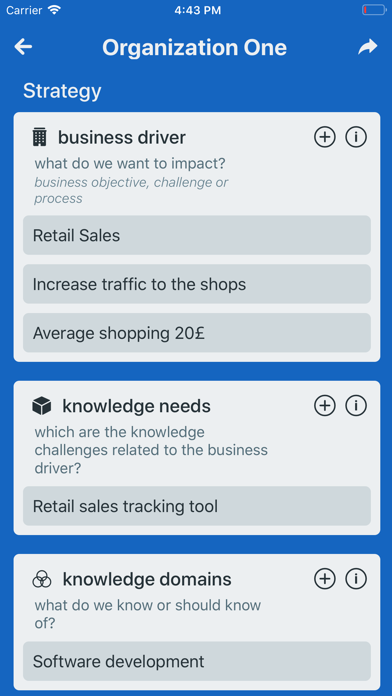
A practical tool to design and visualize a knowledge management strategy linked to key business challenges for the organization and adequate to its capabilities and resources.
KM Strategy Planner, a new version that we have developed taking advantage of the latest experiences generated in our projects and also the multiple comments and questions received as a result of its publication.
We have further detailed the elements linked to the business dimension, and contributed a little more guidance for the description of the knowledge processes and the monitoring metrics.
The new structuring of the tool allows us to visualize 3 dimensions of analysis integrated by 8 work blocks:
The analysis dimensions are:
1. Strategy: Align business challenges, what do you want to impact ?, with knowledge needs linked to this challenge, what are the challenges of knowledge linked to the challenge ?, and knowledge domains associated with such needs? We know or we should know.
2. Operation: Define the processes or initiatives to meet knowledge needs, how will we manage the knowledge domains identified, and describe the organizational elements necessary for their implementation (spaces, channels, roles, policies, communication / recognition actions, etc.).
3. Follow-up: Describe the metrics necessary to track and assess the success of the strategy in terms of activity (actions carried out, participation, etc.), knowledge (skills or pieces of knowledge generated) and business (impact on KPIS, objectives, etc.).
And the work plans:
1. Business focuses. What do we want to impact? Here the business focuses are established, to which the knowledge management initiatives will point.
2. Challenges of knowledge. What are the knowledge challenges related to the business challenge? Define in this case the main concerns that the organization has from a perspective of skills and knowledge.
3. Key knowledge: What do we know or what should we know to cover the needs raised? Here it is important to link the themes or areas of know-how that influence or can influence the challenges posed.
4. Knowledge Processes. How to manage the key knowledge domains? We can formulate initiatives around four key processes:
Connect.
Order.
Socialize
Develop.
5. Regulators. What are the rules of the game? It establishes the guidelines of knowledge management to maintain cohesion, regulate and moderate the development of knowledge processes, all in harmony with the set of corporate values.
6. Enablers. What will we use? Technological channels to facilitate registration processes, organization and dissemination of content, and collaborative classroom environments to facilitate the transfer of knowledge.
7. Dynamizers. How will we stimulate knowledge processes? Poses the consideration and / or deployment of communication, awareness and recognition instruments, as well as the dedication of resources that incorporate the necessary energy, to stimulate the people of the organization, in participation in the processes of generation, assimilation, exchange and renewal of knowledge.
8. Indicators. How will we measure the impact of knowledge management? It proposes monitoring indicators to assess the health and impact of knowledge management in three dimensions:
Activity indicators.
Knowledge indicators.
Business indicators
Going through these 8 work plans, not only can you define and visualize a knowledge management strategy linked to the needs of the business, but we will also make sure to articulate and take advantage of systemic initiatives that may be isolated, thus maximizing their performance and effectiveness .



